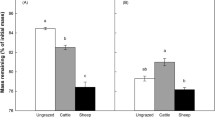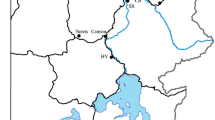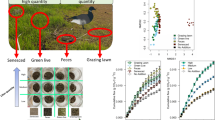Abstract
Herbivores can directly impact ecosystem function by altering litter quality of an ecosystem or indirectly by shifting the composition of microbial communities that mediate nutrient processes. We examined the effects of tree susceptibility and resistance to herbivory on litter microarthropod and soil microbial communities to test the general hypothesis that herbivore driven changes in litter inputs and soil microclimate will feedback to the microbial community. Our study population consisted of individual piñon pine trees that were either susceptible or resistant to the stem-boring moth (Dioryctria albovittella) and susceptible piñon pine trees from which the moth herbivores have been manually removed since 1982. Moth herbivory increased piñon litter nitrogen concentrations (16%) and decreased canopy precipitation interception (28%), both potentially significant factors influencing litter and soil microbial communities. Our research resulted in three major findings: (1) In spite of an apparent increase in litter quality, herbivory did not change litter microarthropod abundance or species richness. (2) However, susceptibility to herbivores strongly influenced bulk soil microbial communities (i.e., 52% greater abundance beneath herbivore-resistant and herbivore-removal trees than susceptible trees) and alkaline phosphatase activity (i.e., 412% increase beneath susceptible trees relative to other groups). (3) Season had a strong influence on microbial communities (i.e., microbial biomass and alkaline phosphatase activity increased after the summer rains), and their response to herbivore inputs, in this semi-arid ecosystem. Thus, during the dry season plant resistance and susceptibility to a common insect herbivore had little or no observable effects on the belowground organisms and processes we studied, but after the rains, some pronounced effects emerged.



Similar content being viewed by others
References
Bailey JK, Wooley SC, Lindroth RL, Whitham TG (2006) Importance of species interactions to community heritability: a genetic basis to trophic-level interactions. Ecol Lett 9:78–85
Bale JS, Masters GJ, Hodkinson ID, Awmack C, Bezemer TM, Brown VK, Butterfield J, Buse A, Coulson JC, Farrar J, Good JEG, Harrington R, Hartley S, Jones TH, Lindroth RL, Press MC, Symrnioudis I, Watt AD, Whittaker JB (2002) Herbivory in global climate change research: direct effects of rising temperature on insect herbivores. Global Change Biol 8:1–16
Bardgett RD, Wardle DA, Yeates GW (1998) Linking above-ground and below-ground interactions: how plant responses to foliar herbivory influence soil organisms. Soil Biol Biochem 30:1867–1878
Bergmeyer HU (1983) Enzymes. In: Bergmeyer HU (ed) Samples, reagents, assessment of results. Methods of Enzymatic Analysis, Verlag-Chemie, Weinheim Deerfield Beach Basel, pp 126–327
Boerner RE, Decker K, Sutherland E (2000) Prescribed burning effects on soil enzyme activity in a southern Ohio hardwood forest: a landscape-scale analysis. Soil Biol Biochem 32:899–908
Boyle SI, Hart SC, Kaye JP, Waldrop MP (2005) Restoration and canopy type influence soil microflora in a ponderosa pine forest. Soil Sci Soc Am J 69:1627–1638
Breshears DD (2006) The grassland-forest continuum: trends in ecosystem properties for woody plant mosaics? Front Ecol Environ 4:96–104
Brown DG (1994) Beetle folivory increases resource availability and alters plant invasion in monocultures of goldenrod. Ecology 75:1673–1683
Brown JH, Whitham TG, Ernest SKM, Gehring CA (2001) Complex species interactions and the dynamics of ecological systems: long-term experiments. Science 293:643–650
Camann MA, Lamoncha KL, Plant NJ (2001) Acari and Collembola at Black mountain experimental forest: and interim report on community structure and prescribed fire effects. USDA Forest Service PSW Research Station Rep
Chapman SK, Hart SC, Cobb NS, Whitham TG, Koch GW (2003) Insect herbivory increases litter quality and decomposition: An extension of the acceleration hypothesis. Ecology 84:2867–2876
Classen AT, Boyle SI, Haskins KE, Overby ST, Hart SC (2003) Community-level physiological profiles of bacteria and fungi: Plate type and incubation temperature influences on contrasting soils. FEMS Microbiol Ecol 44:319–328
Classen AT, Hart SC, Whitham TG, Cobb NS, Koch GW (2005) Insect infestations linked to shifts in microclimate: Important climate change implications. Soil Sci Soc Am J 69:2049–2057
Classen AT, DeMarco J, Hart SC, Whitham TG, Cobb NS, Koch GW (2006) Impacts of herbivorous insects on decomposer communities during the early stages of primary succession in a semi-arid woodland. Soil Biol Biochem 38:972–982
Cobb NS, Whitham TG (1993) Herbivore deme formation on individual trees: A test-case. Oecologia 94:496–502
Cobb NS, Trotter III RT, Whitham TG (2002) Long-term sexual allocation in herbivore resistant and susceptible pinyon pine (Pinus edulis). Oecologia 130:78–87
Dale VH, Joyce LA, McNulty S, Neilson RP, Ayers MP, Flannigan MD, Hanson PJ, Irland LC, Lugo AE, Peterson CJ, Simberloff D, Swanson FJ, Stocks BJ, Wooton BM (2001) Climate change and forest disturbances. BioScience 51:723–734
Davidson EA, Eckert RW, Hart SC, Firestone MK (1989) Direct extraction of microbial biomass nitrogen from forest and grassland soils of California. Soil Biol Biochem 21:773–779
Eivazi F, Tabatabai MA (1977) Phosphatases in soils. Soil Biol Biochem 9:162–172
Eivazi F, Bayan M (1996) Effects of long-term prescribed burning on the activity of select soil enzymes in an oak-hickory forest. Can J Forest Res 26:1799–1804
Ganeshamurthy AN, Nielsen NE (1990) Arylsulfatase and the biochemical mineralization of soil organic sulfur. Soil Biol Biochem 22:1163–1165
Garland J, Mills A (1991) Classification and characterization of heterotrophic microbial communities on the basis of patterns of community-level sole-carbon-source-utilization. Appl Environ Microbiol 57:2351–2359
Garland J 1996 Analytical approaches to the characterization of samples of microbial communities using patterns of potential C source utilization. Soil Biol Biochem 28:213–221
Gehring CA, Whitham TG (1991) Herbivore-driven mycorrhizal mutualism in insect-susceptible pinyon pine. Nature 353:556–557
Gehring CA, Cobb NS, Whitham TG (1997) Three-way interactions among ectomycorrhizal mutualists, scale insects and resistant and susceptible pinyon pines. American Naturalist 149:824–841
Hansen RA (1999) Red oak litter promotes a microarthropod functional group that accelerates its decomposition. Plant Soil 209:37–45
Hansen RA, Coleman DC (1998) Litter complexity and composition are determinants of the diversity and species composition of oribatid mites (Acari: Oribatida) in litterbags. Appl Soil Ecol 9:7–23
Hart SC (1988) Carbon and nitrogen accretion and dynamics in volcanic ash deposits from different subarctic habitats. Biol Fertility Soils 7:79–87
Haubensak KA, Hart SC, Stark JM (2002) Influences of chloroform exposure time and soil water content on C and N release in forest soils. Soil Biol Biochem 34:1549–1562
Hooten JA, Ort MA, Eslon MD (2001) Origin of cinders in Wupatki National Monument, Technical Report 2001-12. Desert Archaeology, Inc, Tucson, AZ
Hungate BA, Jaeger CH, Gamara G, Chapin FS, Field CB (2000) Soil microbiota in two annual grasslands: responses to elevated atmospheric CO2. Oecologia 124:589–598
Karl TR, Knight RW (1998) Comments on “Secular trends of precipitation amount, frequency, and intensify in the United States” - Reply. Bull Am Meteorol Soc 79:2552–2554
Krämer S, Green DM (2000) Acid and alkaline phosphatase dynamics and their relationship to soil microclimate in a semiarid woodland. Soil Biology and Biochemistry 32:179–188
Kuske CR, Ticknor LO, Busch JD, Gehring CA, Whitham TG (2003) The pinyon rhizosphere, plant stress, and herbivory affect the abundance of microbial decomposers in soils. Microbial Ecol 45:340–352
Maraun M, Alphei J, Beste P, Bonkowski M, Buryn R, Migge S, Peter M, Schaefer M, Scheu S (2001) Indirect effects of carbon and nutrient amendments on the soil meso- and micro-fauna of a beechwood. Biol Fertility Soils 34:222–229
McLean EO (1992) Soil pH and lime requirement. In: Page AL (ed) Methods of soil analysis. Chemical and microbiological properties. American Society of Agronomy and Soil Science Society of America, Madison, WI, pp 199–224
Mopper S, Maschinski J, Cobb NS, Whitham TG (1991) A new look at habitat structure: consequences of herbivore-modified plant architecture. In: Bell SS, McCoy ED, Mushinsky HR (eds) Habitat structure: the physical arrangement of objects in space. Chapman and Hall Ltd., London, pp 260–280
Mopper S, Mitton JB, Whitham TG, Cobb NS, Christensen KM (1991) Genetic differentiation and heterozygosity in pinyon pine associated with resistance to herbivory and environmental. Evolution 45:989–999
New M, Todd M, Hulme M, Jones P (2001) Precipitation measurements and trends in the twentieth century. Int J Climatol 21:1899–1922
O’Connell AM (1987) Litter decomposition, soil respiration and soil chemical and biochemical properties at three contrasting sites in Karri (Eucalyptus diversicolor F. Muell.) forests of south-western Australia. Aust J Ecol 12:31–40
Olander LP, Vitousek PM (2000) Regulation of soil phosphatase and chitinase activity by N and P availability. Biogeochemistry 49:175–190
Osler GHR, Gauci CS, Abbott LK (2004) Limited evidence for short-term succession of microarthropods during early phases of surface litter decomposition. Pedobiologia 48:37–49
Parmesan C (2006) Ecological and evolutionary responses to recent climate change. Annu Rev Ecol Evol Syst 37:637–669
Reynolds BC, Crossley DA, Hunter MD (2003) Response of soil invertebrates to forest canopy inputs along a productivity gradient. Pedobiologia 47:127–139
Ritchie ME, Tilman D, Knops JMH (1998) Herbivore effects on plant and nitrogen dynamics in oak savanna. Ecology 79:165–177
Ruel J, Whitham TG (2002) Fast-growing juvenile pinyons suffer greater herbivory when mature. Ecology 83:2691–2699
Rustad LE, Campbell JL, Marion GM, Norby R, Mitchell MJ, Hartley AE, Cornelissen JHC, Gurevitch J (2001) A meta-analysis of the response of soil respiration, net nitrogen mineralization, and aboveground plant growth to experimental ecosystem warming. Oecologia 126:543–562
Santos PF, Depree E, Whitford WG (1978) Spatial distributions of litter and microarthropods in a Chihuahuan desert ecosystem. J Arid Environ 1:41–48
Schowalter TD, Sabin TE (1991) Litter microarthropod responses to canopy herbivory, season and decomposition in litterbags in a regenerating conifer ecosystem in Western Oregon. Biol Fertility Soils 11:93–96
Seastedt TR, Crossley Jr. DA, Hargrove WW (1983) The effects of low-level consumption by canopy arthropods on the growth and nutrient dynamics of black locust and red maple trees in the southern Appalachians. Ecology 64:1040–1048
Shaw JD, Steed BE, DeBlander LT (2005) Forest Inventory and Analysis (FIA) annual inventory answers the question: What is happening to pinyon-juniper woodlands? J For 103:280–285
Shuster SM, Lonsdorf EV, Wimp GM, Bailey JK, Whitham TG (2006) Community heritability measures the evolutionary consequences of indirect genetic effects on community structure. Evolution 60:991–1003
Sinsabaugh A (1994) Enzymatic analysis of microbial pattern and process. Biol Fertility Soils 17:69–74
Swaty RL, Gehring CA, Van Ert M, Theimer TC, Keim P, Whitham TG (1998) Temporal variation in temperature and rainfall differentially affects ectomycorrhizal colonization at two contrasting sites. New Phytol 139:733–739
Tabatabai MA, Bremmer JM (1970) Arylsulfatase activity of soils. Soil Sci Soc Am J 34:225–229
Tarafdar J, Kiran B, Rao A (1989) Phosphatase activity and distribution of phosphorous in arid soil profiles under different land use patterns. J Arid Environ 16:29–34
Taylor AR, Wolters V (2005) Responses of oribatid mite communities to summer drought: The influence of litter type and quality. Soil Biol Biochem 37:2117–2130
White TCR (1969) An index to measure weather-induced stress of trees associated with outbreaks of psyllids in Australia. Ecology 50:905–909
White TCR (1993) The inadequate environment. Springer, Berlin Heidelberg, New York
Whitford WG (1996) The importance of the biodiversity of soil biota in arid ecosystems. Biodiv Conserv 5:185–195
Whitford WG (1996) The importance of the biodiversity of soil biota in arid environments. Biodiv Conserv 5:185–195
Whitham TG, Mopper S (1985) Chronic herbivory: Impacts on architecture and sex expression of pinyon pine. Science 228:1089–1091
Whitham TG, Bailey JK, Schweitzer JA, Shuster SM, Bangert RK, Leroy CJ, Lonsdorf EV, Allan GJ, DiFazio SP, Potts BM, Fischer DG, Gehring CA, Lindroth RL, Marks JC, Hart SC, Wimp GM, Wooley SC (2006) A framework for community and ecosystem genetics: from genes to ecosystems. Nat Rev Genet 7:510–523
Acknowledgements
We thank M. Dickerson and J. DeMarco, who helped with sample collection and analysis. S. Boyle and D. Guido assisted with enzyme analysis. S. Chapman assisted with field and laboratory work. G. Crutsinger gave insightful comments on the manuscript. G. Newman and P. Selmants gave useful soil information. NSF grants (DEB9816001, DEB0236204), a NAU undergraduate Hooper fellowship awarded to J. Demarco and M. Dickerson, fellowships awarded to A.T. Classen from the Merriam-Powell Center for Environmental Research and the American Association of University Women, and the U.S. Department of Energy, Office of Science, Biological and Environmental Research Program funded this work. ORNL is managed by UT-Battelle, LLC, for the U.S. Department of Energy under contract DE-AC05-00OR22725.
Author information
Authors and Affiliations
Corresponding author
Additional information
Responsible Editor: Angela Hodge.
Rights and permissions
About this article
Cite this article
Classen, A.T., Overby, S.T., Hart, S.C. et al. Season mediates herbivore effects on litter and soil microbial abundance and activity in a semi-arid woodland. Plant Soil 295, 217–227 (2007). https://doi.org/10.1007/s11104-007-9277-6
Received:
Accepted:
Published:
Issue Date:
DOI: https://doi.org/10.1007/s11104-007-9277-6




